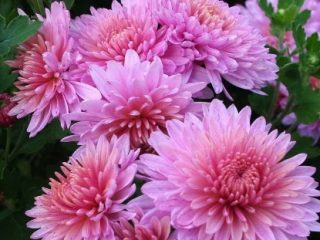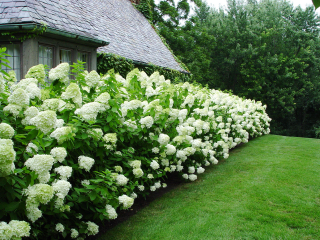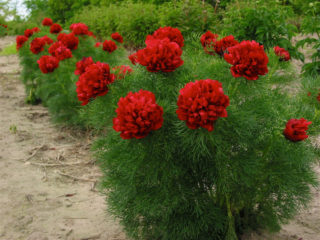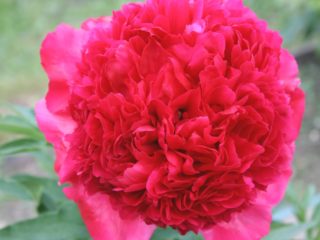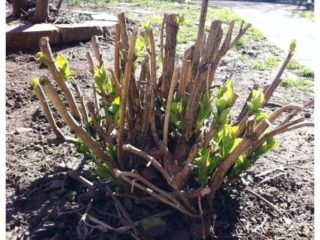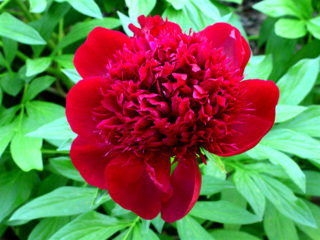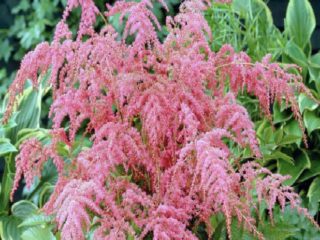Content
- 1 The best varieties of white roses with photos and names
- 2 Application in landscape design
- 3 Conclusion
White roses come in a wide variety of varieties. There are large and miniature plant species, bush and ground cover. All of them are widely used in landscape design.
The best varieties of white roses with photos and names
Varieties of the white rose flower differ from each other in the structure and shade of the buds, the dimensions of the bushes and other features. Before planting a crop on a site, it is recommended to study its diversity.
Varieties of white climbing roses
Climbing white roses are used mainly for landscaping vertical structures. Long flexible shoots of the plant can be conveniently placed on the supports of arbors, arches and fences.
Long John Silver
The American climbing rose reaches 3.5 m above the ground. It grows as a bush and is also well suited for staking. It spreads up to 2.5 m wide, bears white buds collected in inflorescences of 3-4 pieces. The shoots of the plant are covered with large thorns, the leaves of the rose are large and round in shape.
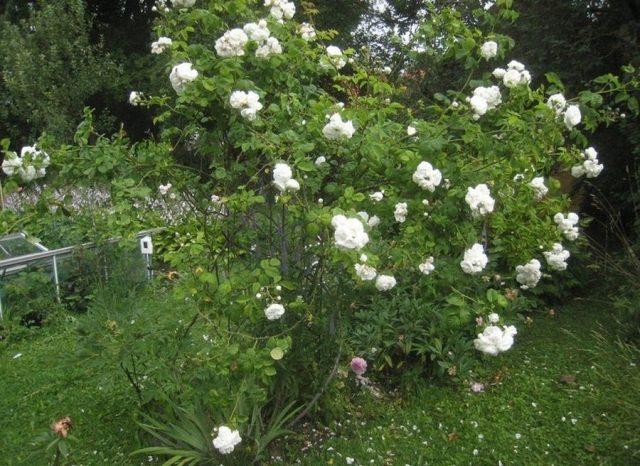
When flowering, the white variety Long John Silver emits a moderate, pleasant aroma.
Aelita
The climbing white rose blooms with large double buds up to 9 cm in diameter. It emits a strong odor and remains decorative throughout the summer. Looks good in sunny areas and does not require frequent pruning.
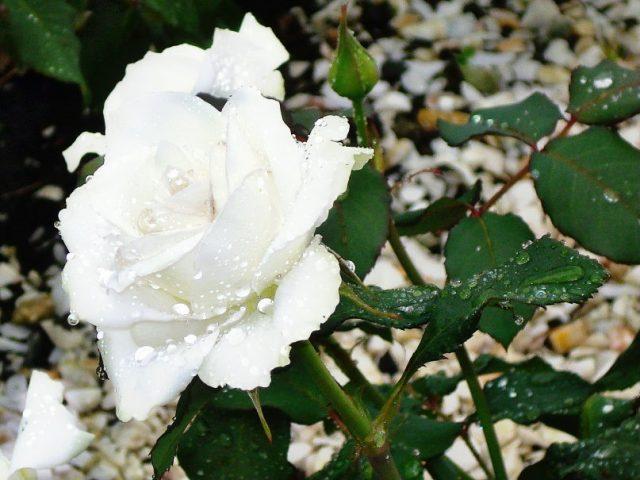
Shoots of the white rose Aelita reach 3 m in length
White Dorothy Perkins
The climbing variety has shoots up to 3 m. It spreads widely to the sides and bears 5-10 flowers on each stem. The white buds are small in size, only up to 5 cm in diameter. Flowering occurs in early summer; during the decorative period the bushes emit a faint aroma.
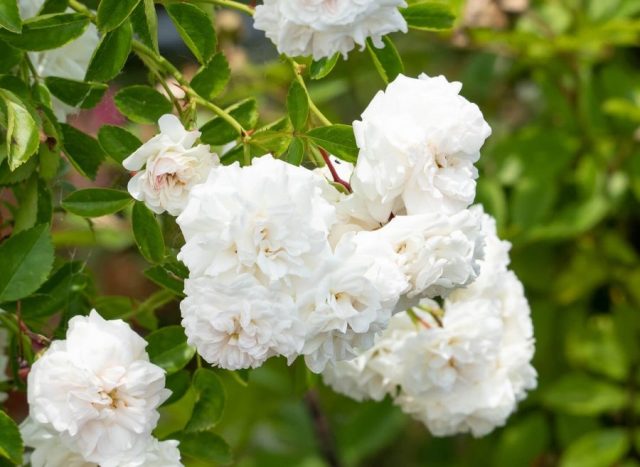
White Dorothy Perkins is a fairly old variety, bred in 1903
Hybrid tea white roses
Hybrid tea white varieties are distinguished by large buds and a strong aroma. They are used for growing on site and for cutting; they remain attractive for a long time.
Virgo
A beautiful white rose with goblet-shaped elongated buds grows up to 1 m above the ground.Forms dense but compact bushes, the leaves of the plant are shiny dark green. The decorative period begins in mid-June and continues until frost. Virgo's buds are semi-double, with a weak aroma. When cut, the flowers do not fade within five days.
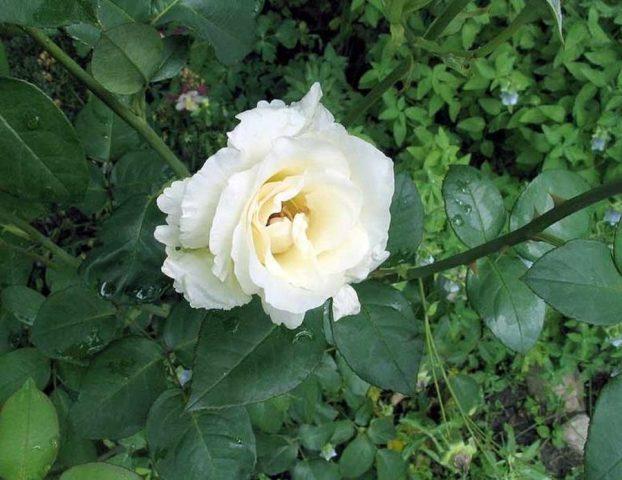
Virgo's white buds reach 12 cm in diameter
Pascali
A tall white rose up to 2 m above the ground bears large buds consisting of 25-40 petals. At first, after blooming, the flowers have a creamy tint, then gradually lighten. The variety has dark leaves and exudes a pleasant sweetish aroma. It begins to bloom in June, bearing buds until the coldest weather with short breaks. The bushes spread up to 120 cm in width.

Rose Pascali opens very slowly and does not fade for a long time after cutting.
White Christmas
The American hybrid tea variety blooms profusely in early summer and towards autumn. The buds are very beautiful, white with a pinkish core, with a pronounced aroma. Each flower reaches 12 cm in diameter. The bushes rise up to 1 m above the ground. The plant rarely suffers from viral and fungal diseases and tolerates rainy periods well.
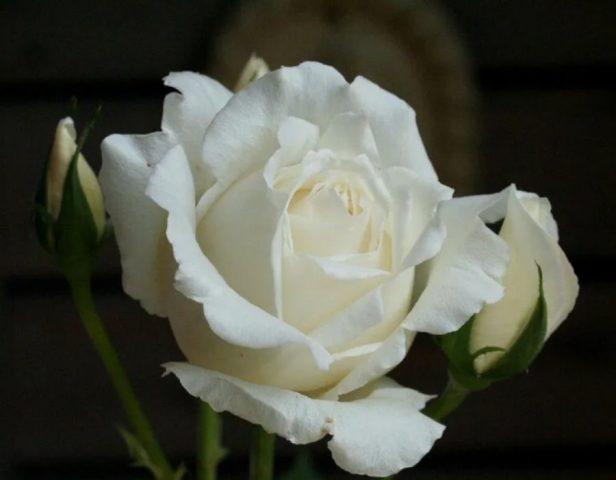
White rose White Christmas spreads up to 75 cm wide
White varieties of park roses
The main feature of park varieties is their increased endurance. Such bushes do not require complex care, tolerate heat and prolonged rains well, and require minimal fertilizing.
Blanc Double de Coubert
French park rose grows up to 2 m above the ground. It produces 1-3 large white buds on each stem and has a very rich aroma. The bushes are quite compact, only up to 50 cm in diameter. The variety is frost-resistant, suitable for growing in temperate climates.It rarely suffers from fungal diseases, but heavy rains can impair flowering.
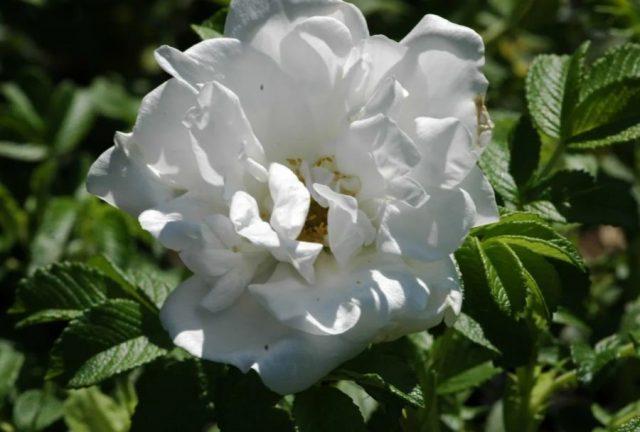
Blanc Double de Coubert tolerates drought and poor soil well
Madame Hardy
The variety of white bush rose was bred in 1832. It is distinguished by its high growth up to 2 m and good spreading ability. The flowers are fragrant, up to five per stem, medium in size. White rose practically does not suffer from powdery mildew and is rarely affected by spotting. There are thorns on the shoots, but there are not many of them, and they usually do not interfere with the care of the bushes.
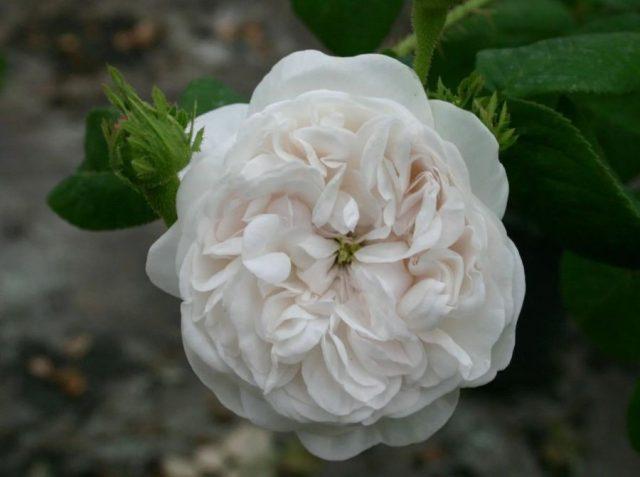
Madame Hardy can withstand cold temperatures down to -28 ° C without shelter
Sir Thomas Lipton
The hybrid tea variety was bred in 1900 and is very popular among gardeners. The buds of the plant are double white, slightly yellowish at the core, up to 7 cm wide. Once fully bloomed, they begin to emit a strong aroma.
The variety is quite hardy, has good immunity to fungi and is not afraid of cold temperatures down to -35 ° C. However, it requires attention in rainy weather, as it can rot from waterlogging.
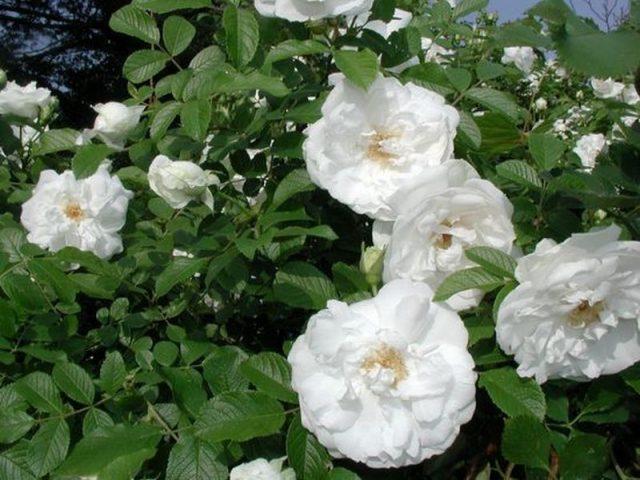
Sir Thomas Lipton reaches 2 m above the ground
Ground cover
Small white roses are called ground cover roses due to their low growth. They are usually used to decorate the foreground of flower beds and decorate empty areas in the garden. Varieties of this type rarely rise above 70 cm above the ground, are distinguished by good immunity to diseases, and are not afraid of humidity.
Snowfield
An unpretentious ground cover variety reaches only 50 cm in height, but the length of the shoots is 1.5 m. The white rose has matte dark green leaves and bears double buds with a slightly light green center. The flowers are small, up to 5 cm wide, but very abundant.The decorative period lasts all summer; the plant tolerates adverse weather conditions well.
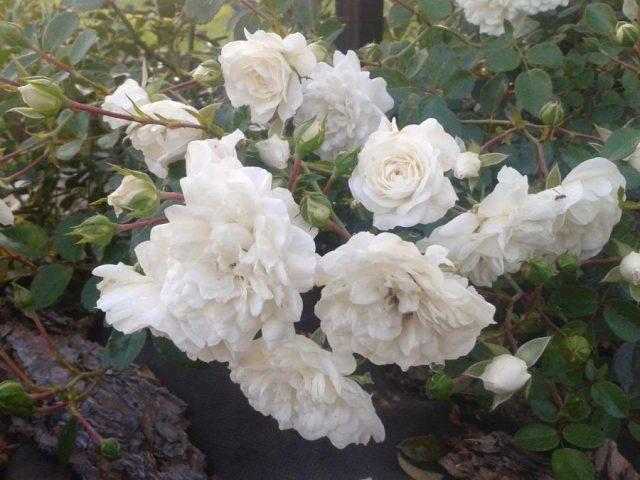
Snowfield is usually not damaged by rain
White Fairy
The ground cover plant blooms from June to the end of October. It blooms with small buds up to 4 cm in diameter. It looks impressive during the decorative period; the foliage is almost completely hidden under numerous white flowers. There are a small number of thorns on the stems. The rose is frost-resistant, suitable for northern regions, and rarely suffers from fungi.

The White Fairy variety grows to a maximum of 70 cm above the ground
Blanc Meidiland
The ground cover variety has been known in cultivation since 1987, bred in France. It is unpretentious, blooms profusely and for a long time - from June to frost. It usually grows only up to 50 cm, spreading up to 80 cm in width. The shoots are dense and covered with thorns, the leaves are glossy, rich green. The small rosette-shaped buds are pure white. The structure of the flowers is densely double.

Blanc Maidiland does not grow well in the shade; it is better to plant a white rose in a moderately lit area
Varieties of large white roses
White roses with flowers more than 10 cm in diameter are considered large. Such varieties look impressive when cut and attract attention when grown on the site.
White Bear
The white hybrid tea rose blooms with huge buds up to 16 cm in diameter. The flowers are densely double, very fragrant, appear on the shoots from June to early November. The variety is quite unpretentious and has good resistance to fungal diseases. The bushes rise up to 1 m in height and spread 80 cm in diameter, the shoots are covered with sparse thorns.The photo of white rose flowers shows that the core of the buds is slightly creamy.

At the peak of its decorative effect, it is recommended to tie the White Bear rose to supports so that the stems do not break under the weight of the flowers.
Akito
The German hybrid tea variety blooms with goblet buds up to 12 cm in diameter. It has straight, strong shoots up to 1 m tall and dark green shiny leaves. The buds are medium-double, consisting of 17-25 petals. Only one flower appears on each stem; the variety is often used for cutting. The aroma of the white rose is weak but pleasant, with raspberry and strawberry notes.
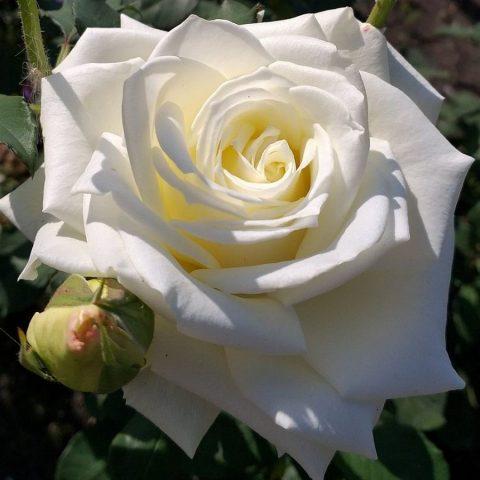
Akito is frost-resistant and winters at -28 ° C without shelter
Avalanche
The white rose Avalange blooms with buds up to 13 cm wide. Remains decorative from June to November, the shoots are straight and spreading, with a small number of thorns. One bud is formed on each stem. The flowers are bright white, but the petals have a slight dark green edge. A yellowish tint is noticeable in the core.
White rose easily tolerates damp weather and heat, and demonstrates good frost resistance. Even if the bushes freeze in winter, they will be able to recover with the onset of spring.

The Avalange rose lasts a long time when cut and is often used in bouquets.
Miniature
White roses with miniature flowers up to 4 cm in diameter are no less interesting than large varieties. The plants bloom very abundantly, and the stems usually do not break from the weight of the buds.
Bobby James
The English white rose bears cup-shaped or flattened buds only 4-5 cm wide. The decorative period lasts throughout the summer, the flowering is very bright and lush. The buds are white, but a creamy or yellowish tint can be seen in the core.Up to six flowers appear on each stem. The shoots are strong, but quite flexible, covered with large dark green leaves.
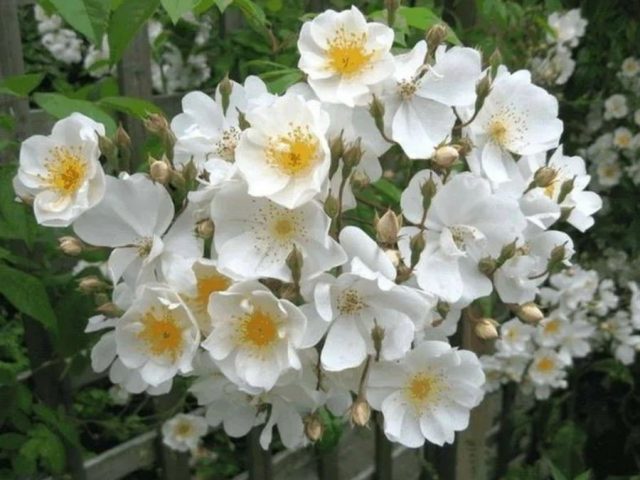
The shoots of the white rose Bobby James can stretch up to 3.5 m in length
White Lydia
The Dutch miniature rose is covered with white goblet buds in early June. The bushes grow up to 80 cm in height and up to 40 cm in diameter, and remain compact when grown. The shoots are devoid of thorns, so the white rose is very easy to care for. The flowers are small, up to 4 cm in diameter, collected in brushes of 5-10 pieces. The aroma of the variety is weak, but gentle and pleasant.
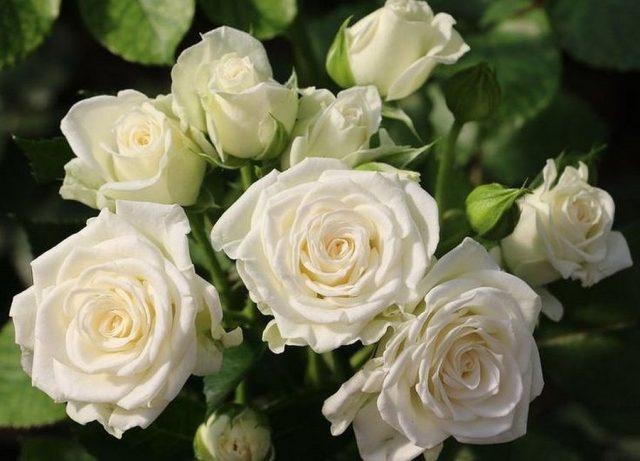
White Lydia finishes flowering closer to November
Waterloo
The white Belgian musk rose has increased shade tolerance and blooms equally profusely in sunny and cloudy weather. Bears double buds up to 3 cm wide. The flowers are cup-shaped, bright or creamy white, sometimes with a greenish tint. Collected in compact brushes of 5-10 pieces.
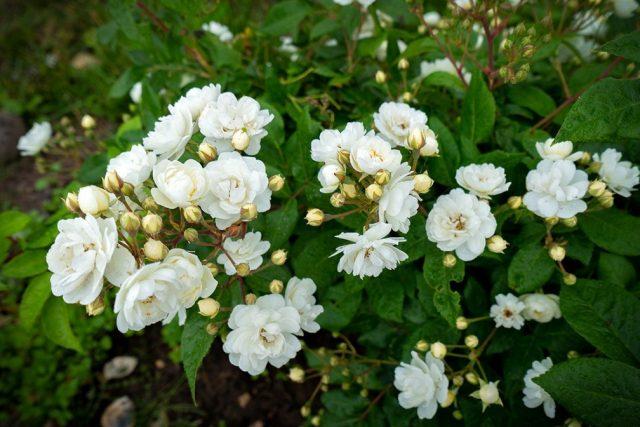
Waterloo rises up to 1.5 m above the ground
Winter-hardy varieties of white roses for the Moscow region
When growing roses in the Moscow region, gardeners often encounter unexpected cold snaps; in the spring, late return frosts may occur. Several varieties of white roses tolerate unfavorable weather best.
Iceberg
The white rose was bred in 1958 and quickly gained popularity due to its unpretentiousness and resistance to disease. The variety blooms profusely throughout most of the summer. The buds are white with a greenish or pinkish tint. Flowers can form lush clusters of 3-15 pieces.
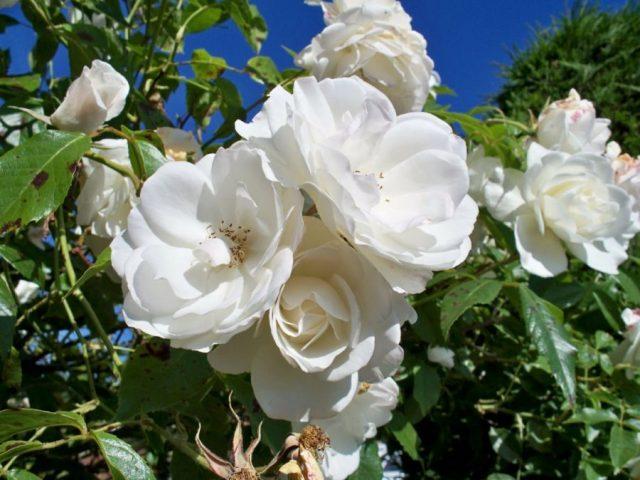
The Iceberg variety tolerates cold temperatures down to -35 °C with minimal shelter
White New Dawn
The climbing rose of American selection has very long shoots up to 4.5 m. It bears cup-shaped flowers with a moderate double structure. The petals are bright white, the core of the buds is yellowish. The peak of decorativeness occurs in July. In August and September, the rose continues to bloom, but not so profusely. The plant is frost-resistant and easily survives the winter in the Moscow region if provided with shelter.
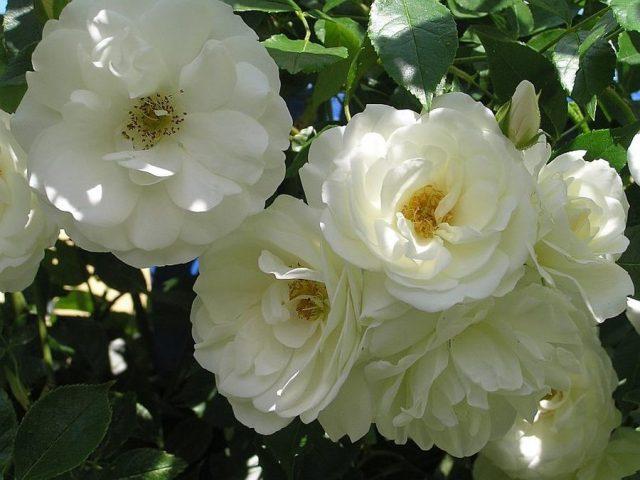
The diameter of the White New Dawn buds is about 8 cm
Margaret Merril
A white rose with straight shoots up to 1.5 m in height blooms with semi-double buds up to 10 cm in width. The center of the flower is usually pinkish. The decorative period lasts from June to the end of autumn; at the beginning of summer, one bud appears on the shoots, then they open in tassels. The variety can easily tolerate temperatures down to -23 °C.
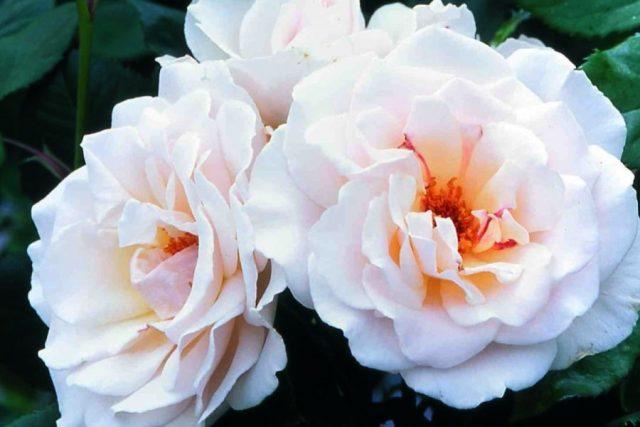
Margaret Merrill emits a citrusy-spicy aroma when blooming
Application in landscape design
White roses in landscape design are most often used to decorate sunny areas. Unlike dark varieties, the flowers do not fade or bake under ultraviolet rays. Tall bush species are used to form hedges and artistic compositions. With the help of ground cover plants, alpine hills, rocky gardens and wide vacant lots on the site are decorated.
White roses can be planted next to red, yellow and pink varieties. It is advisable to combine only 2-3 shades so that the flower garden does not look too colorful. Good neighbors for the crop are bells and carnations, as well as low daisies.

White roses look impressive against the backdrop of medium-sized, rich green shrubs and conifers
Conclusion
White roses are particularly decorative and bright and combine with most perennials on the site. There are many hardy varieties of crops that require minimal care.
https://youtu.be/OLp29XKi3o8
